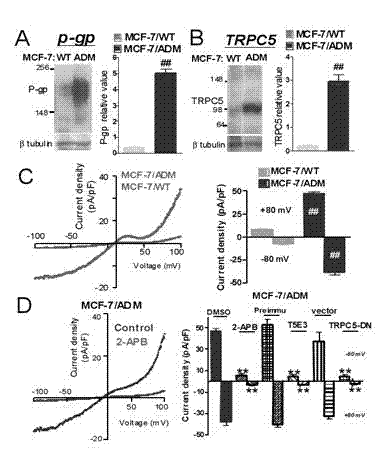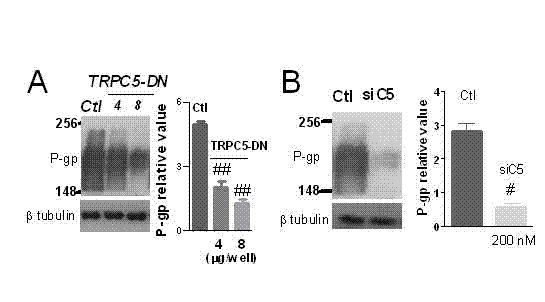Application of TRPC5 as drug target in reversing multi-drug resistance
A multi-drug resistance and drug technology, which can be used in anti-tumor drugs, drug combinations, medical preparations containing active ingredients, etc., and can solve problems such as unseen applications
- Summary
- Abstract
- Description
- Claims
- Application Information
AI Technical Summary
Problems solved by technology
Method used
Image
Examples
Embodiment 1
[0031] Example 1 Expression level of TRPC5 in multidrug resistant tumor cells and detection of calcium ion permeation activity
[0032] experimental method:
[0033] Collect 1.0x10 each of MCF-7 / WT and MCF-7 / ADM 5 The differences in the expression levels of P-gp and TRPC5 in MCF-7 / WT and MCF-7 / ADM were detected by Western blot.
[0034] HEKA EPC9-9 patch clamp system was used to detect MCF-7 / WT and MCF-7 / ADM and the whole-cell currents of MCF-7 / WT and MCF-7 / ADM after being treated with various TRPC5 inhibitors. The clamping voltage of the cell is 0mV, the current-voltage relationship is -100mV~+100mV, the interval is 20 mV, and the duration is 500ms. The composition of the electrode inner solution: 130mM Cs-aspartate Cs-aspartate, 2 mM MgCl 2 , 5 mM Na 2 ATP, 5.9 mM CaCl 2 , 10 mM EGTA, 10 mM hydroxyethylpiperazine ethylsulfuric acid Hepes (pH7.2); the electrode external fluid is a hypotonic solution with an osmotic pressure of 210mOsm, and its composition is: 65mM Na + -...
Embodiment 2
[0040] Example 2 Detection of relationship between TRPC5 and P-gp expression levels
[0041] MCF-7 / ADM was seeded in a six-well plate at a density of 300,000 cells per well, and after 12 hours of culture, the dominant inhibitory plasmid pCDNA6-TRPC5-DN of TRPC5 was transfected (4 μg / well, 8 μg / well ), with pCDNA6 empty plasmid as the control group, and TRPC5 siRNA siC5 (100pmol / well) (the intentional strand is: CCA AUG GAC UGA ACC AGC UUU ACU U), with negative siRNA as the control group; The cells were routinely cultured, and the cells in each well were collected after 24 hours. According to the conventional operation method, the expression of P-gp in the cells before and after TRPC5 was inhibited was detected by Western blot. Among them, the primary antibody for P-gp incubation was Anti-P-gp (P-glycoprotein), the primary antibody for incubation of TRPC5 is TRPC5 antibody (ab63151), the primary antibody for internal reference βtubulin is β tubulin antibody (SC-9104), and the s...
Embodiment 3
[0044] Example 3 Reversal effect of TRPC5 inhibitors on multidrug resistance of tumor cells in vitro
[0045] experimental method:
[0046] MCF-7 / ADM and MCF-7 / WT were inoculated on 25cm 2 When the MCF-7 / ADM confluence was 80%, the dominant suppressor plasmid pCDNA6-TRPC5-DN (16 μg / flask) of TRPC5 was transfected respectively, and the pCDNA6 empty plasmid was used as the control group, and the SiRNA siC5 of TRPC5 ( 200pmol / bottle), negative siRNA was used as the control group; the cells were cultured routinely, and after 24 hours, the above-treated MCF-7 / ADM and untreated MCF-7 / WT were collected respectively, and 7000 cells per well The density was inoculated in a 96-well plate. After 24 hours, doxorubicin was added according to the concentration gradient. After culturing for 48 hours, the drug sensitivity of the cells was detected by the MTT method.
[0047] Experimental results:
[0048] See the experimental results image 3 . Depend on image 3 -A and 3-B, it can be s...
PUM
 Login to View More
Login to View More Abstract
Description
Claims
Application Information
 Login to View More
Login to View More - R&D
- Intellectual Property
- Life Sciences
- Materials
- Tech Scout
- Unparalleled Data Quality
- Higher Quality Content
- 60% Fewer Hallucinations
Browse by: Latest US Patents, China's latest patents, Technical Efficacy Thesaurus, Application Domain, Technology Topic, Popular Technical Reports.
© 2025 PatSnap. All rights reserved.Legal|Privacy policy|Modern Slavery Act Transparency Statement|Sitemap|About US| Contact US: help@patsnap.com



